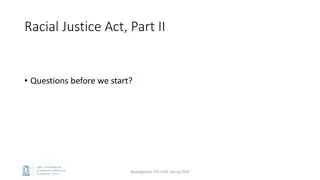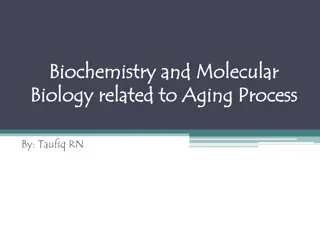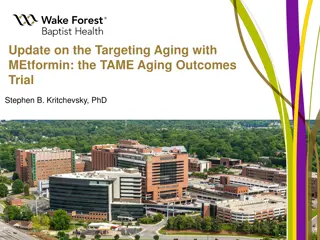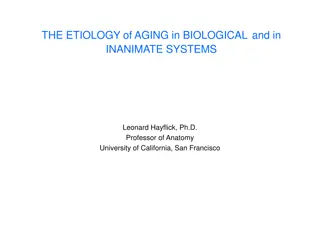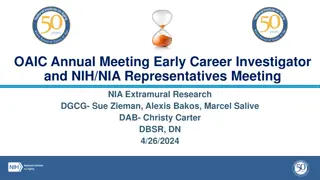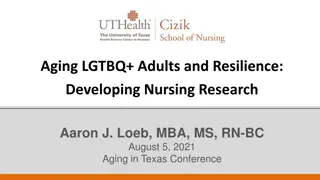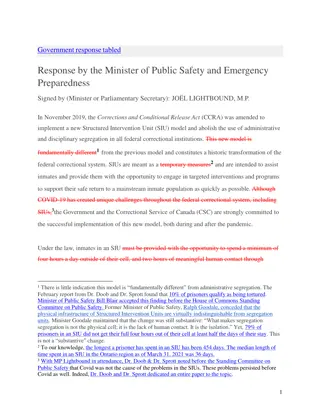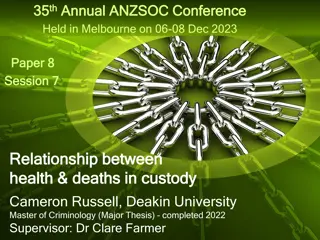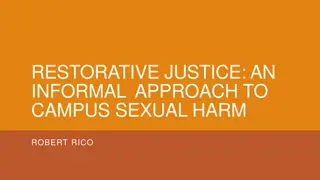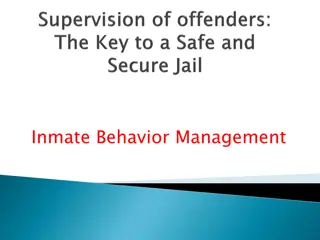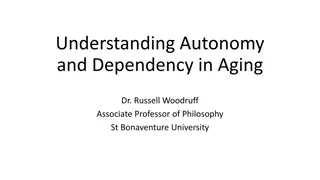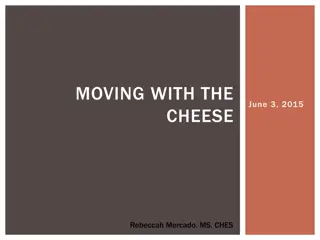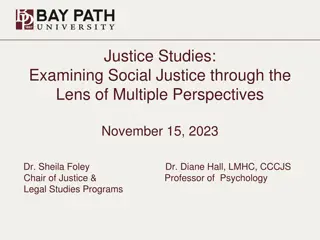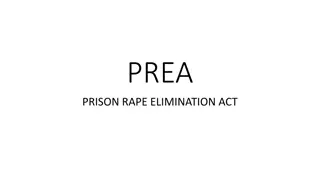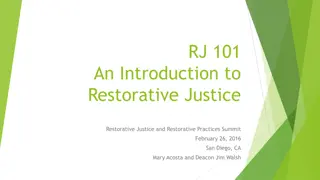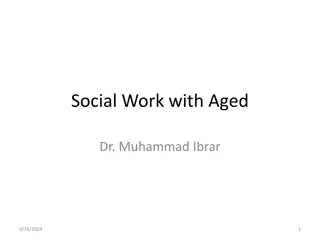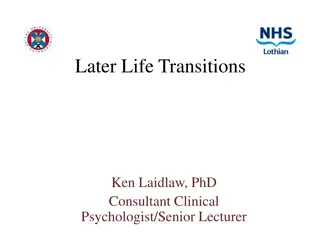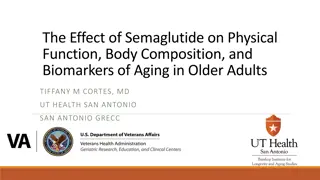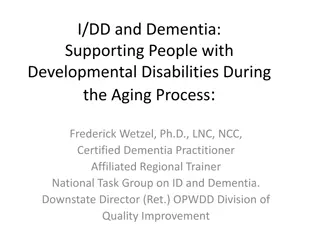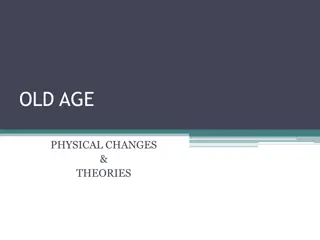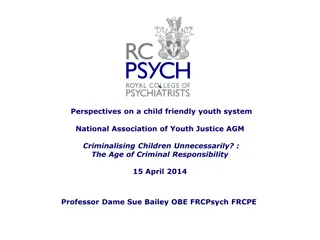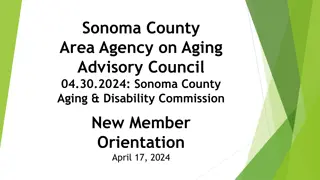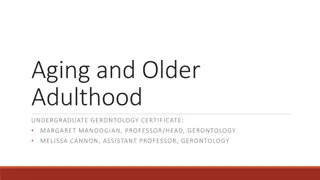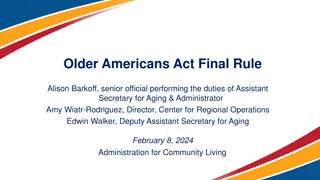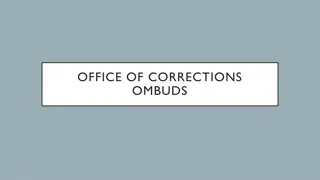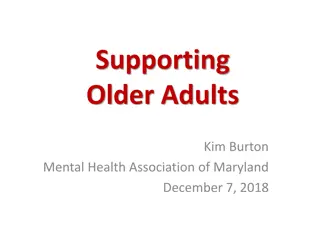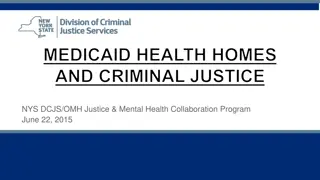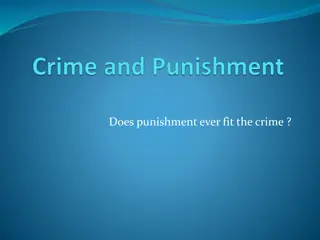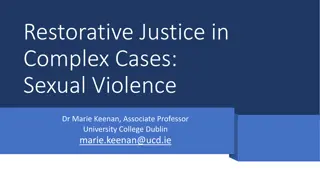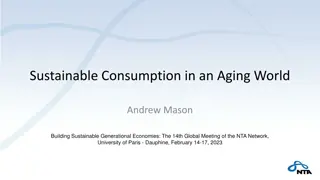Addressing Aging Inmates: Challenges and Solutions in New Mexico's Justice System
The rise in aging inmates in New Mexico's prisons presents unique challenges due to their health and medical needs. These inmates often face chronic conditions, substance abuse issues, and mental health disorders, making them more costly to care for compared to younger inmates. With a growing population of older prisoners, the state must address the implications of an aging prison demographic through medical and geriatric parole programs and other specialized interventions.
Download Presentation

Please find below an Image/Link to download the presentation.
The content on the website is provided AS IS for your information and personal use only. It may not be sold, licensed, or shared on other websites without obtaining consent from the author. Download presentation by click this link. If you encounter any issues during the download, it is possible that the publisher has removed the file from their server.
E N D
Presentation Transcript
National Association of Sentencing Commissions 2022 Annual Conference Plenary Session 3, 9 August 2022 Curbing Extreme Sentences: Medical and Geriatric Parole, and Juveniles Sentenced as Adults in New Mexico MSC02 1625 | Albuquerque, NM 87131 | (505) 277-3494 | nmsc.unm.edu
NMSC organizational statutes Sections 9-3-10 through 9-3-12 NMSA (1978). Section 9-3-10 NMSA: D. The New Mexico sentencing commission shall: * * * government on policy matters relating to criminal and juvenile justice; (5) advise the executive, judicial and legislative branches of changes to laws relating to the criminal and juvenile justice systems that the commission determines would improve those systems. (6) make recommendations to the legislature concerning proposed MSC02 1625 | Albuquerque, NM 87131 | (505) 277-3494 | nmsc.unm.edu
New Mexicos Medical and Geriatric Parole Program Section 31-21-25.1 NMSA 1978 Section 31-21-17.1 NMSA 1978 MSC02 1625 | Albuquerque, NM 87131 | (505) 277-3494 | nmsc.unm.edu
The increase in the number and percentage of aging inmates is due in part to medical advances. Yet such inmates often have long histories of alcohol and drug abuse, insufficient diet, and lack of medical care. The combination of physical and mental declines makes aging inmates, on the average, 10 to 11.5 years older physiologically than their nonincarcerated age peers. This is why most recent studies consider either age 50 or 55 as the onset of old age for inmates. . . . Compared to younger inmates, older inmates have poorer health, especially regarding chronic conditions, substance abuse, and psychological disorders. [One study] found that older inmates suffered an average of three chronic illnesses during their incarceration. Because of health and other aging-related needs, older prisoners are up to 3 times more costly to maintain than younger inmates; older inmates use more prescription drugs than younger inmates and spend twice as much time in medical facilities. Rikard, R. V., & Rosenberg, E. Aging Inmates: A Convergence of Trends in the American Criminal Justice System , Journal of Correctional Health Care 13(3):150-162. (July 2007) (citations omitted) MSC02 1625 | Albuquerque, NM 87131 | (505) 277-3494 | nmsc.unm.edu
NMSCs latest Prison Population forecast 19% of New Mexico s male inmates are older than 50, representing slightly over 1,000 people. 12% of the female population is older than 50, representing around 65 people. These numbers are lower than national averages 39% for males, 16% for females. MSC02 1625 | Albuquerque, NM 87131 | (505) 277-3494 | nmsc.unm.edu
Key Elements of SB114 (2021) Medical and Geriatric Parole Bill Dropping the age of eligibility for a geriatric inmate from 65 to 55. Inmates over 55 are provided with a copy of the medical and geriatric parole policy at least once a year. An inmate arriving at a long-term care or geriatric unit is provided with a copy of the medical and geriatric parole policy. Affirmative obligation to notify inmates of the opportunity to apply for medical or geriatric parole, and recommend for release inmates who are eligible. NMCD has 30 days from receipt of the application to make a recommendation to the Parole Board. MSC02 1625 | Albuquerque, NM 87131 | (505) 277-3494 | nmsc.unm.edu
Key Elements of SB114 (2021) Medical and Geriatric Parole Bill (continued) The Parole Board has 15 days to decide whether to grant parole the Board shall release an inmate on medical or geriatric parole unless the Board finds by clear and convincing evidence that the inmate's release is incompatible with the welfare of society. The Board shall not deny medical or geriatric parole solely because of the nature of the charge resulting in the inmate's conviction or the inmate's criminal history. Accelerated schedule for terminally ill inmates NMCD must make a recommendation within 15 days, and the Parole Board has 7 days to make their decision. Process for an appeal of denial of medical or geriatric parole to the District Court the Parole Board has 48 hours to file the record, and the court has 72 hours to issue its decision. An inmate convicted of first degree murder shall not be considered eligible for medical or geriatric parole. MSC02 1625 | Albuquerque, NM 87131 | (505) 277-3494 | nmsc.unm.edu
Ira v. Janecka, 2018-NMSC-027 Ira was 14 and 15 when he committed his crimes. Sentenced to 91 years in 1997 after pleading no contest to ten counts of criminal sexual penetration, one count of aggravated battery resulting in great bodily harm, one count of aggravated battery against a household member, and one count of intimidation of a witness. He would be first eligible for parole after 46 years (presuming good behavior), that is, when he was 62. MSC02 1625 | Albuquerque, NM 87131 | (505) 277-3494 | nmsc.unm.edu
Ira v. Janecka, 2018-NMSC-027 Whether the rationale of these cases, and in particular Graham, should be applied to a term-of-years sentence for the commission of multiple crimes is the preliminary question we must answer. If Graham applies, we must next consider whether Ira s long consecutive sentence effectively deprives him of a meaningful opportunity to obtain release by demonstrating his maturity and rehabilitation, thereby violating the prohibition of cruel and unusual punishment. {Para. 3} MSC02 1625 | Albuquerque, NM 87131 | (505) 277-3494 | nmsc.unm.edu
Ira v. Janecka, 2018-NMSC-027 We conclude that Graham applies when a multiple term-of-years sentence will in all likelihood keep a juvenile in prison for the rest of his or her life because the juvenile is deprived of a meaningful opportunity to obtain release by demonstrating his or her maturity and rehabilitation. {Para. 4} MSC02 1625 | Albuquerque, NM 87131 | (505) 277-3494 | nmsc.unm.edu
Ira v. Janecka, 2018-NMSC-027 In this case, Ira can be eligible for a parole hearing when he is 62 years old if he demonstrates good behavior under the EMDA. Therefore, based on the record before us, we conclude that Ira has a meaningful opportunity to obtain release by demonstrating his maturity and rehabilitation before the Parole Board. {Para. 4} MSC02 1625 | Albuquerque, NM 87131 | (505) 277-3494 | nmsc.unm.edu
Ira v. Janecka, 2018-NMSC-027 The New Mexico Legislature is at liberty to enact legislation providing juveniles sentenced to lengthy term-of-years sentences with a shorter period of time to become eligible for a parole eligibility hearing. {Para. 38} Although we consider Ira s opportunity to obtain release when he is 62 years old constitutionally meaningful, albeit the outer limit, we do not intend to discourage the legislature from adopting a shorter time period as have many other jurisdictions. {Para. 39} MSC02 1625 | Albuquerque, NM 87131 | (505) 277-3494 | nmsc.unm.edu
Position statement from the American Academy of Child and Adolescent Psychology Juvenile offenders serving life without parole should have an initial review of their sentences within five years of sentencing or by age 25, whichever comes first. As maturation and rehabilitation are ongoing processes, subsequent reviews should occur no less than every three years. Research demonstrates that brain development continues throughout adolescence and into early adulthood. The frontal lobes, which are critical for mature reasoning and impulse control, are among the last areas of the brain to mature. They are not fully developed until the early to mid-20's. Any sentence review must include a review of educational and court documents as well as a comprehensive mental health evaluation, conducted by a child mental health professional, such as a child and adolescent psychiatrist. The mental health evaluation must include a family interview, prenatal history, developmental history, medical history, academic history, legal history, history of mental health interventions, history of treatment for substance use, social history and a psychological evaluation. American Academy of Child and Adolescent Psychology, Juvenile Life Without Parole: Review of Sentences (2011) (available at: https://www.aacap.org/aacap/policy_statements/2011/Juvenile_Life_Without_Parole_Review_ of_Sentences.aspx) MSC02 1625 | Albuquerque, NM 87131 | (505) 277-3494 | nmsc.unm.edu
People age out of crime and recidivism declines with age. The age-crime curve is a longstanding and well-tested concept in criminology, depicting the proportion of individuals in each age group that is engaged in criminal activity. For a range of offenses, crime rates peak around the late teenage years and begin a gradual decline in the early 20s. . . . Aging out of crime is a key reason why people who have been imprisoned for violent crimes who generally serve longer sentences are the least likely to recidivate when released from prison. Ghandnoosh, A Second Look at Injustice (The Sentencing Project, 2021) (footnotes omitted) (available at: https://www.sentencingproject.org/publications/a-second-look-at- injustice/). MSC02 1625 | Albuquerque, NM 87131 | (505) 277-3494 | nmsc.unm.edu
Key Elements of SB43 (2022) The Juvenile Parole/JLWOP Bill Abolishes sentences of life without parole for juveniles sentenced as adults. A juvenile sentenced as an adult is entitled to a parole hearing after 15 years this applies whether the juvenile s sentence is concurrent or consecutive. A new review, upon denial of parole, every 5 years thereafter. MSC02 1625 | Albuquerque, NM 87131 | (505) 277-3494 | nmsc.unm.edu
Key Elements of SB43 (2022) The Juvenile Parole/JLWOP Bill (continued) The Parole Board is to consider the diminished culpability of juveniles as compared to that of adults and the hallmark features of youth, including immaturity, impetuosity and failure to appreciate risks and consequences. Parole Board to review all offenders currently serving sentences as adults for offenses committed as a child to ensure they receive the required hearings. Retroactivity provision so that the law s provisions apply to all juveniles serving adult sentences. MSC02 1625 | Albuquerque, NM 87131 | (505) 277-3494 | nmsc.unm.edu
From the NMSC Organizing Statutes Section 9-3-10 NMSA (1978): D. The New Mexico sentencing commission shall: * * * government on policy matters relating to criminal and juvenile justice; (5) advise the executive, judicial and legislative branches of changes to laws relating to the criminal and juvenile justice systems that the commission determines would improve those systems. (6) make recommendations to the legislature concerning proposed MSC02 1625 | Albuquerque, NM 87131 | (505) 277-3494 | nmsc.unm.edu
Douglas H. M. Carver Deputy Director New Mexico Sentencing Commission dhmcarver@unm.edu (505) 239-8362 www.nmsc.unm.edu MSC02 1625 | Albuquerque, NM 87131 | (505) 277-3494 | nmsc.unm.edu


